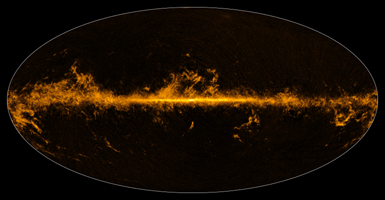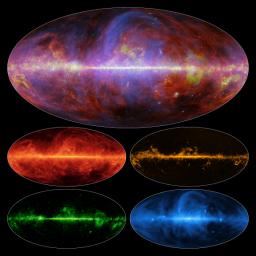
Unannotated Version
Download the high resolution TIFF file
Click on the image for larger browse versionA new, dynamic portrait of our Milky Way galaxy shows a frenzy of gas, charged particles and dust. The main composite image comes from the European Space Agency's Planck mission, in which NASA plays an important role. It is constructed from observations made at microwave and millimeter wavelengths of light, which are longer than what we see with our eyes.
The various components making up the main image are shown below it:
-- Dust Glow (upper left). The red colors making up this map show light coming from the thermal glow of dust throughout our galaxy. The dust is cold, only about 20 degrees above absolute zero (20 Kelvin).
-- Carbon Monoxide Gas (upper right). Yellow shows carbon monoxide gas, which is concentrated along the plane of our Milky Way in the densest clouds of gas and dust that are churning out new stars.
-- Careening Particles (lower left). The green shows a kind of radiation known as free-free. This occurs when isolated electrons and protons careen past one another in a series of near collisions, slowing down but continuing on their own way (the name free-free comes from the fact that the particles start out alone and end up alone). The free-free signatures are associated with hot, ionized gas near massive stars.
-- Captured in Magnetic Fields (lower right). Blue indicates a type of radiation called synchrotron, which occurs when fast-moving electrons, spit out of supernovas and other energetic phenomena, are captured in the galaxy's magnetic field, spiraling along them near the speed of light.
Planck is a European Space Agency mission, with significant participation from NASA. NASA's Planck Project Office is based at JPL. JPL contributed mission-enabling technology for both of Planck's science instruments. European, Canadian and U.S. Planck scientists work together to analyze the Planck data.
More information is online at http://www.nasa.gov/planck, http://planck.caltech.edu and http://www.esa.int/planck.

 Planetary Data System
Planetary Data System













